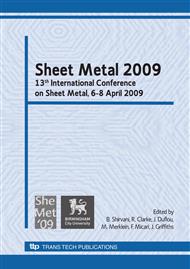p.97
p.105
p.117
p.127
p.143
p.151
p.159
p.169
p.177
Tool Path Generation for Free Form Surfaces in Robot-Based Incremental Sheet Metal Forming
Abstract:
This paper describes a new development in incremental, robot-based sheet metal forming (Roboforming). Roboforming is a dieless sheet metal forming process which ensures cost-effective manufacturing of prototype parts and small batches. Its principle is based on flexible shaping by means of a freely programmable path synchronous movement of two industrial robots driving work-piece independent forming tools. The final shape is produced by the incremental inward motion of the forming tool in depth direction and its movement along the contour in lateral direction on a heli-cal path. The supporting tool, with its simple geometry, holds the sheet on the backside by moving syn¬chronously along the outer contour, at constant depth. In this way no special dies are needed. For mil¬ling machines, which are used in numerous incremental forming approaches, CAD/CAM inter¬faces exist for generating necessary tool paths. For industrial robots only a few simple solutions emerge, which do not have the potential of classical CAD/CAM interfaces and are unusable for co-operating robot systems. While the two coupled robot programs can be programmed manually for simple geometries, this approach does not work for complex geometries. In this paper a further de-velopment in robot programming systems is presented that is now able to derive helical tool paths from any CAD file and generate two cooperating programs for the forming and the sup¬porting tools. The helixes pitch is variable and dependent on the geometry’s wall angle. To increase the part accu¬racy a process database is used, that stores relevant information about the process pa¬rameters, sensor data and used equipment. Based on this information strategies for increasing the part accuracy can be applied.
Info:
Periodical:
Pages:
143-150
Citation:
Online since:
March 2009
Authors:
Keywords:
Price:
Сopyright:
© 2009 Trans Tech Publications Ltd. All Rights Reserved
Share:
Citation:


